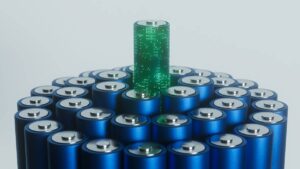Battery makers are planning to use a lot more HPA to stop cars catching fire

Pic: Bloomberg Creative / Bloomberg Creative Photos via Getty Images
Demand for High Purity Alumina — a critical safety material in lithium batteries — is expected to grow dramatically as battery component makers invest in new production capacity.
That’s the conclusion of HPA explorer Hill End Gold (ASX:HEG) after a series of meetings with battery makers in China and the US.
HPA — created from aluminous clay using various chemical procedures — is used as a base material for making lithium ion battery components, LED lights, smart phone screens and surgical tools.
One of HPA’s fastest growing applications is coating the separators that keep apart the cathode and anode electrodes in a lithium battery — to prevent explosions.
“One Chinese battery separator manufacturer was currently using three tonnes of HPA a day, which was going to increase to 45 tonnes per day – or 16,000 tonnes a year,” Hill End Gold managing director Martin McFarlane told Stockhead.
Hill End Gold (ASX:HEG) is developing a low-cost, 8000-tonne per annum HPA project called Yendon near Ballarat, Victoria.
Tenfold increase
Another battery separator maker told Hill End it planned to increase in its capacity tenfold in the next five years. A third said they would invest as much as $300 million to ramp up production.
“We knew they were going up — but the size of those expansions plans really took us by surprise,” Mr McFarlane said.
Up to 70 per cent of battery separators would be coated in HPA in the future compared to less than 30 per cent today, he said.
- Bookmark this link for small cap breaking news
- Discuss small cap news in our Facebook group
- Follow us on Facebook or Twitter
- Subscribe to our daily newsletter
“They were very keen to speak with us, and they were very interested in our [Yendon] project,” Mr McFarlane said.
“We spoke with them for an hour and half, and most of that was them asking questions, and talking about their qualification process to get new suppliers across the line.
“I certainly think that – reading between the lines – they were looking to spread their supplier base a little bit.”
>> Read Stockhead’s quick guide to High Purity Alumina
Lower costs
Unlike existing producers, HPA players such as Altech (ASX:ATC) , FYI Resources (ASX:FYI) and Hill End Gold produce HPA from an aluminous clay called kaolin which results in lower costs.
“The existing producers have operating costs of about $15,000 to $17000 per tonne,” Mr McFarlane said.
“By using kaolin as a feedstock you’re talking about operating costs of $7700/t — it’s less than half the operating costs of current producers.”
FYI Resources has just released its Preliminary Feasibility Study for its Cadoux kaolin project, which, with a sale price assumption of $US24,000 per tonne, would deliver an operating margin of about $US17,500 per tonne.
What is the outlook for HPA and electric cars?
Analysts at London-based mining research group CRU are particularly bullish on HPA, Mr McFarlane said.
“CRU is forecasting the total HPA market to get to about 125,000t by 2025 – about half of that will be batteries,” he said.
“That’s from about 4000t or 5000t in 2016.
“The balance will come from the sapphire market which will continue to grow – just as not at such a rapid pace, because it is already a large market.”
HPA is a critical ingredient in the production of synthetic sapphire, which is used in LED lights and speciality glass.
Even with conservative estimates of between 60,000t and 70,000t of HPA by 2025, “there’s more than enough demand for new HPA producers to come into the market without disrupting the existing producers”, Mr McFarlane said.
UNLOCK INSIGHTS
Discover the untold stories of emerging ASX stocks.
Daily news and expert analysis, it's free to subscribe.
By proceeding, you confirm you understand that we handle personal information in accordance with our Privacy Policy.








